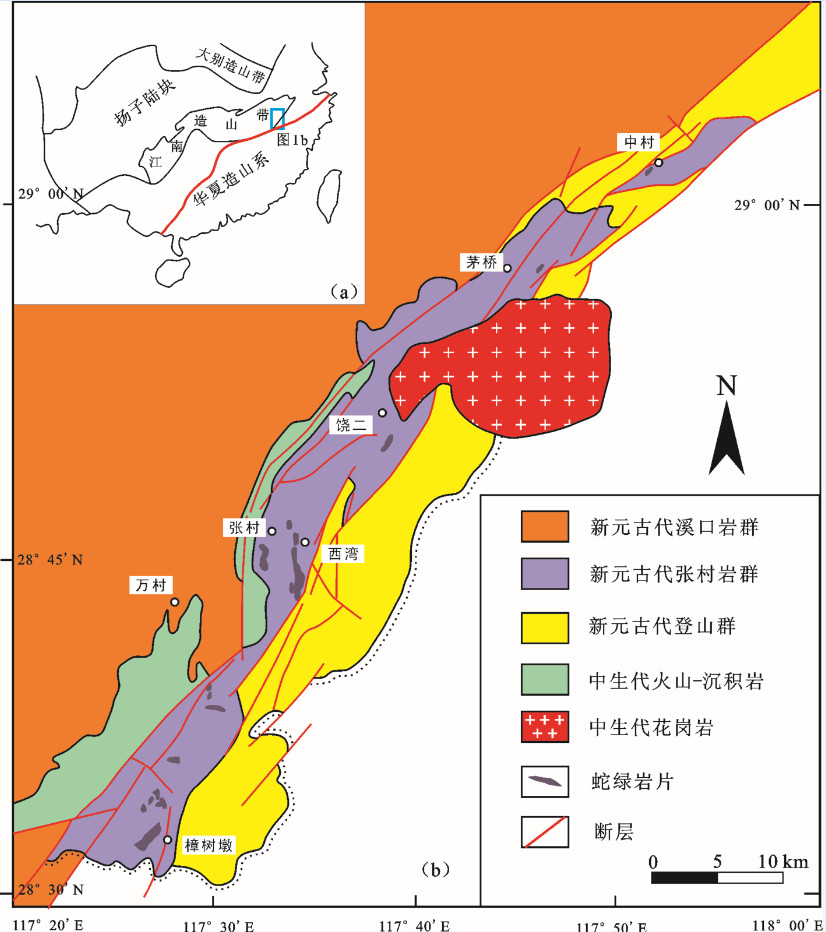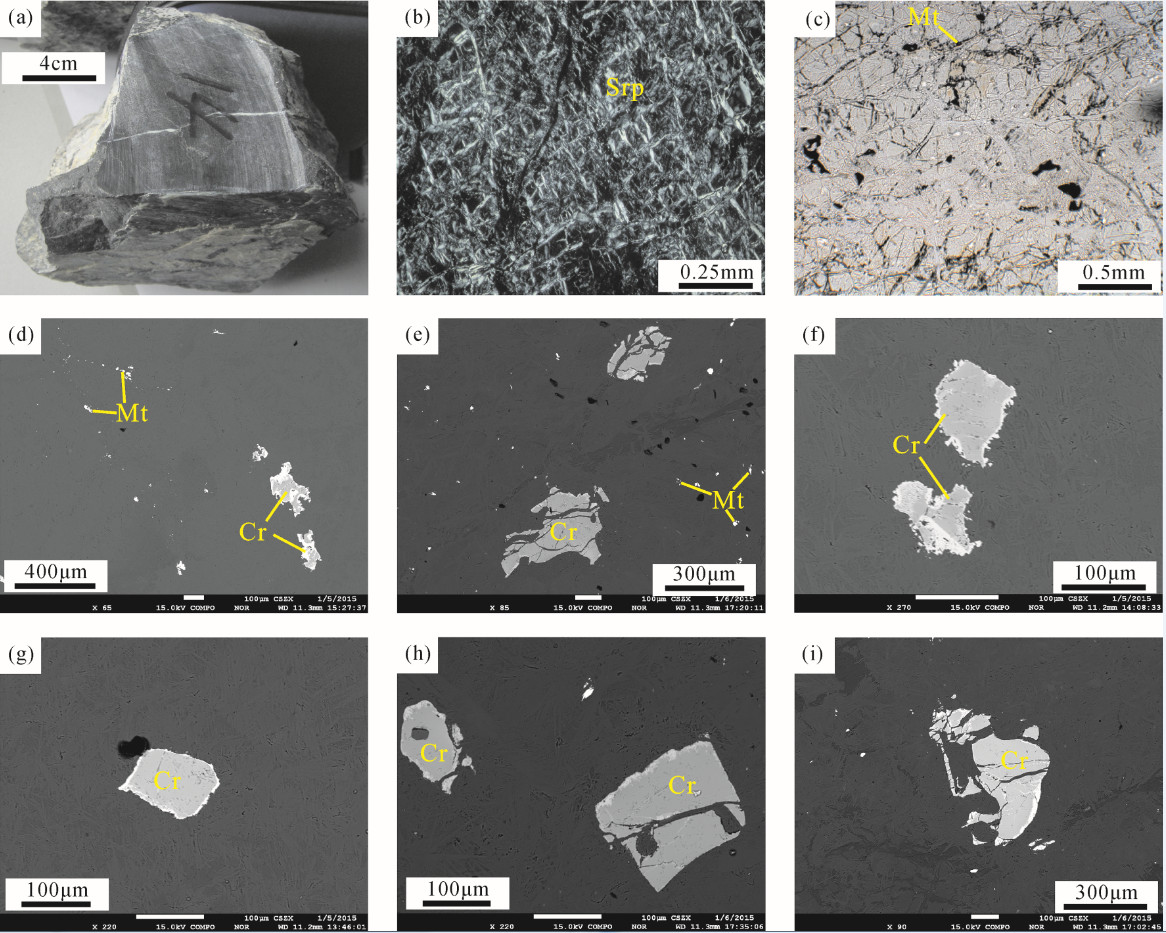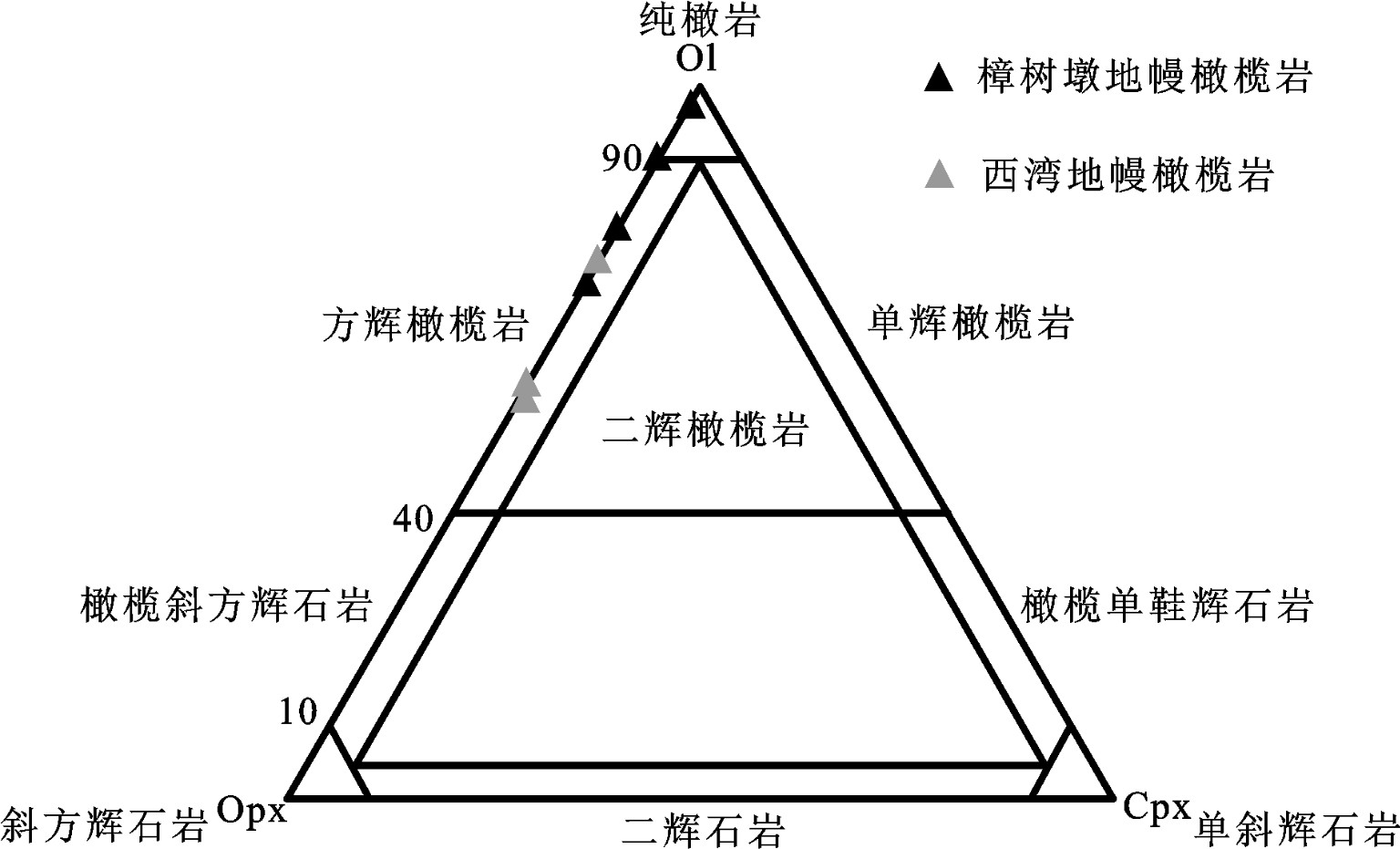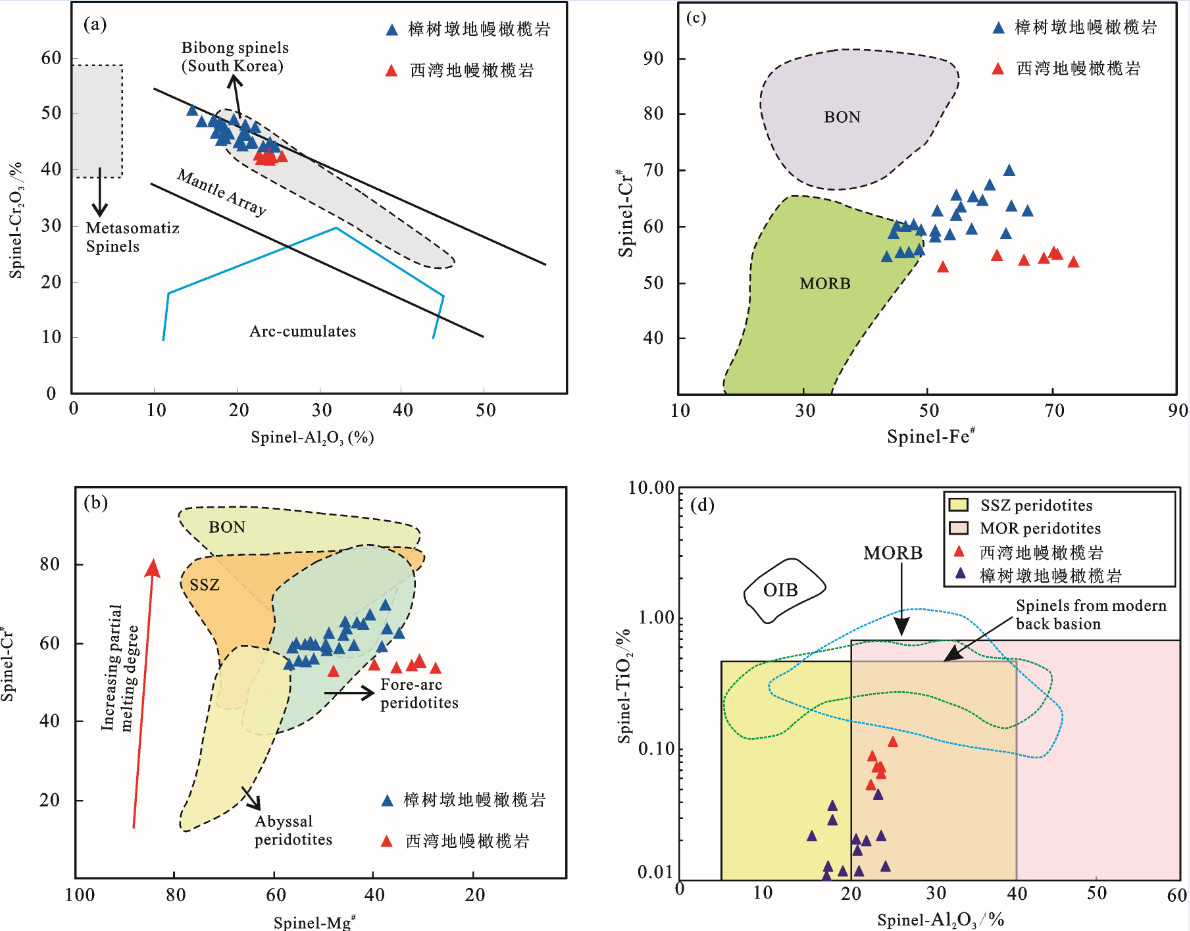The origin of the mantle peridotite from ophiolitite in northeast Jiangxi and its geological implications
-
摘要:
赣东北蛇绿岩作为华南少有的前寒武纪蛇绿岩长期都是华南大地构造研究中的热点。该蛇绿岩地幔橄榄岩以方辉橄榄岩为主,稀土总量为0.83×10-6~2.62×10-6,远低于原始地幔的含量,而MgO含量高于原始地幔。稀土元素表现为LREE相对富集,微量元素表现为大离子亲石元素(LILE)富集,高场强元素Nb明显亏损的特征,这表明赣东北地幔橄榄岩具有亏损地幔源区特征,同时也有不同程度的俯冲带流体的交代特征。HREE模拟的部分熔融程度为10%~30%;同时,赣东北蛇绿岩地幔橄榄岩中同时包含Cr#>60和Cr# < 60两种不同成因的铬尖晶石,说明其经历了MOR(mid-ocean ridge)和SSZ(supra-subduction zone)两种构造环境。结合前人资料,笔者推测赣东北蛇绿岩早先可能形成于洋中脊环境(约1060 Ma),随后在洋内俯冲作用下(约970 Ma),位于俯冲带上部的地幔橄榄岩受到了来自俯冲带的流体/熔体的交代,经历了SSZ环境的改造。
Abstract:The ophiolite in northeast Jiangxi is one of rare Precambrian ophiolites in Jiangnan orogenic belt and also a hot topic for the tectonics of South China. The mantle peridotite mainly consists of harzburgite. Compared with primitive mantle, the peridotites have lower total REE values varying from 0.83×10-6 to 2.62×10-6 and higher MgO content. On the chondrite-normalized REE patterns, the rocks display enriched LREE patterns. When normalized to primitive mantle, all samples show variable enrichment of LILEs and are characterized by significant Nb negative anomalies. These features imply a depleted mantle source, which was overlapped by fluid alteration in a subduction zone. On the HREE patterns, the calculation shows that the harzburgites exhibit the residues of 10%-30% partial melting of the mantle source. Meanwhile, the spinels from mantle peridotites in northeast Jiangxi can be divided into two types which are Cr#>60 and Cr# < 60 in the light of their chemical compositions. It is thus concluded that the spinels are of characteristics of both MOR and SSZ setting. In combination with previous researches, the authors infer that ophiolites in northeast Jiangxi originated in a MOR setting at ca. 1060 Ma, and was modified by melts and fluids in a SSZ mantle wedge at ca. 970 Ma.
-
Keywords:
- mantle peridotite /
- spinel /
- ophiolite in northeast Jiangxi MOR /
- SSZ /
-
1. 引言
稀土(Rare earth)是元素周期表中镧系元素和钪、钇共17种金属元素的总称。稀土是重要的自然资源,更是宝贵且关键的战略资源,在民用和军事方面用途十分广泛,同时也是先进装备制造业、新能源、新兴产业等高新技术产业不可或缺的原材料。在全球范围内,稀土资源分布不均,其主要分布于美国、俄罗斯、中国、印度、巴西等国家。中国稀土储量约占世界总储量的23%,却承担了世界90%以上的市场供应(中华人民共和国国务院新闻办公室, 2012)。经半个多世纪的过度开采,中国稀土资源保有储量及保障年限不断下降,鉴于此,发现和利用新类型稀土矿,可有效提高中国稀土资源储量,有力保障国家稀土资源供给安全。
稀土矿床按成因分类主要有碱性岩—碱性超基性岩型、碳酸岩型、花岗岩型、砂矿型以及风化壳型(徐光宪, 1995);按工业类型分类主要有稀土-磁铁矿矿床、含稀土碳酸岩矿床、花岗岩风化壳型稀土矿床、含稀土伟晶岩矿床、含稀土磷块岩矿床以及独居石砂矿床(矿产资源工业要求手册, 2014)。近年来,多位学者报道在贵州威宁地区二叠系宣威组一段黏土岩中富含稀土元素,但是由于该稀土资源的综合利用技术多年来未取得突破(黄训华, 1997; 张震和戴朝辉, 2010; 周灵洁, 2012),稀土元素的赋存状态、富集机理以及稀土矿床成因类型等方面存在较大争议。2018年以来,笔者在滇东—黔西地区开展地质调查,发现研究区内广泛发育的二叠系宣威组富稀土黏土岩系属沉积成因,有别于Wang et al.(2018)提及的南方离子吸附型稀土矿,而类似于文俊等(2021)报道的川南沐川地区宣威组底部古风化壳-沉积型铌、稀土矿,该新类型稀土矿具有矿石禀赋好、矿层厚度大且较连续、“关键稀土元素(Critical rare earth element; Pr, Nd, Tb, Dy)”占比较高等特点,并伴生有铌、锆、镓等有价元素,其中镓的平均品位高达70.5×10-6,高于工业品位(Zhang et al., 2010)。另外,在稀土资源开发利用方面取得了重大突破,针对该稀土资源研发了“选择性浸出”新工艺(徐璐等, 2020),使稀土回收率可达90%以上,该新类型稀土资源有望实现规模化工业利用。滇东—黔西地区沉积型稀土资源的发现与利用,将有力支撑国家关键稀土资源战略储备。
2. 区域地质背景
滇东—黔西地区大地构造位置位于扬子板块西缘(潘桂棠等, 2009),以北西向康定—水城断裂、北东向弥勒—师宗深大断裂带以及近南北向小江断裂所挟持的三角形地带(图 1)。区内地层属华南地层大区的扬子地层区之上扬子地层分区,主体位于黔西北地层小区,部分涉及到云南的昭通地层小区及曲靖地层小区。晚中生代以前主要是海相碳酸盐岩及陆源硅质碎屑岩,以后则主要为陆相沉积。火成岩主要为海西晚期陆相溢流的峨眉山玄武岩及同源异相的浅成侵入岩。
![]() ①—怒江断裂;②—金沙江—红河断裂;③—鲜水河断裂;④—龙门山山前断裂;⑤—小金河断裂;⑥—箐河—程海断裂;⑦—安宁河—绿汁江断裂;⑧—小江断裂;⑨—康定—水城断裂;⑩—弥勒—师宗断裂Figure 1. Sketch map showing geotectonic position of the research area (after Luo Yaonan, 1985; Zhang Zhibin et al., 2006)①-Nujiang fault; ②-Jinsha River—Red River fault; ③-Xian Shui River fault; ④-Longmen Mountain piedmont fault; ⑤-Xiao Jian River fault; ⑥-Jing River—Chenghai fault; ⑦-Anning River—Lü zhi River fault; ⑧-Xiao River fault; ⑨-Kang ding—Shui cheng fault; ⑩-Mile—Shizong fault
①—怒江断裂;②—金沙江—红河断裂;③—鲜水河断裂;④—龙门山山前断裂;⑤—小金河断裂;⑥—箐河—程海断裂;⑦—安宁河—绿汁江断裂;⑧—小江断裂;⑨—康定—水城断裂;⑩—弥勒—师宗断裂Figure 1. Sketch map showing geotectonic position of the research area (after Luo Yaonan, 1985; Zhang Zhibin et al., 2006)①-Nujiang fault; ②-Jinsha River—Red River fault; ③-Xian Shui River fault; ④-Longmen Mountain piedmont fault; ⑤-Xiao Jian River fault; ⑥-Jing River—Chenghai fault; ⑦-Anning River—Lü zhi River fault; ⑧-Xiao River fault; ⑨-Kang ding—Shui cheng fault; ⑩-Mile—Shizong fault3. 测试分析方法
在研究区内采集了186件宣威组一段沉积型稀土矿石样品,正样经破碎研磨至200目,取缩分样50 g/件,送至中国地质科学院矿产综合利用研究所分析测试中心,利用电感耦合等离子体质谱仪(Perkinelmer Optima Nexion 350X)测得稀土配分数据;再取稀土含量(TREO)较高的毛家坪矿点、鱼布沟矿点缩分样20 g/件,送至中国地质科学院矿产综合利用研究所岩石与工艺矿物学研究室,利用X射线衍射仪(日本理学Ultima Ⅳ)测得主要矿物成分。选取稀土含量(TREO)较高的毛家坪矿点、鱼布沟矿点矿石副样,块样用切割机(MecatomeT330)切成3 cm×1 cm×2 cm样品,用环氧树脂镶嵌制光片坯样;松散样经研磨至40目,用环氧树脂镶嵌制砂片坯样。以上坯样用自动磨抛机(EcomeT300)制得直径为3.5 cm圆柱形待测样品,将待测样品送至中国地质科学院矿产综合利用研究所岩石与工艺矿物学研究室,利用英国蔡司(ZEISS)Sigma 500型场发射扫描电镜及配套的德国布鲁克能谱仪(EDS)获取数据,并应用矿物特征自动定量分析软件(AMICS)进行矿物参数全自动定量分析。
4. 稀土资源特征
4.1 富稀土岩系特征
研究区内富稀土岩系发育于二叠系宣威组一段(P3x1)。宣威组出露面积较广(图 2),北至昭通金阳—大关一带,向南经昭通、威宁一直延伸至宣威—六盘水等地,呈北窄南宽的形态展布。宣威组平行不整合于二叠系峨眉山玄武岩组(P2-3em)之上、整合于三叠系东川组(T1dc)之下,是一套乐平世滨岸及湖沼相与同期曲流河相伴生产出的沉积地层,并且多出现在河泛平原背景上,无独立的大型湖泊沉积体系(戴传固, 2017)。
据笔者对威宁县哲觉镇小箐沟(东经103°59′ 08″,北纬26°36′37″)二叠系宣威组一段典型地层剖面(Pm201)研究,查明宣威组一段富稀土岩系主要为灰白色铝土质黏土岩与粉砂质黏土岩互层(图 3a、b),偶见植物碎屑,中部夹砾屑砂岩(图 3f),砾屑呈次圆状,粒度2~4 mm不等,由下往上砾屑粒度表现出粗—细—粗的渐变特征;岩石碎裂呈砂状、松散片状(图 3c),局部可见层理构造;稀土含量较高的岩石主要为铝土质黏土岩(图 3d、e)、粉砂质黏土岩(⑨~⑪层,⑬~⑮层)。
![]() 图 3 贵州威宁哲觉镇宣威组一段(P3x1)剖面-柱状图a—宣威组一段典型剖面;b—宣威组一段柱状图;c、d、e—铝土质黏土岩;f—砾屑砂岩Figure 3. Typical profile and histogram of the first part of Xuanwei Group (P3x1) in the Zhejue town of Weining area, Guizhou Provincea-Typical section of the first part of Xuanwei Group; b-Histogram of the first passage of Xuanwei Group; c, d, e-Bauxitic clay rock; f-Gravel sandstone
图 3 贵州威宁哲觉镇宣威组一段(P3x1)剖面-柱状图a—宣威组一段典型剖面;b—宣威组一段柱状图;c、d、e—铝土质黏土岩;f—砾屑砂岩Figure 3. Typical profile and histogram of the first part of Xuanwei Group (P3x1) in the Zhejue town of Weining area, Guizhou Provincea-Typical section of the first part of Xuanwei Group; b-Histogram of the first passage of Xuanwei Group; c, d, e-Bauxitic clay rock; f-Gravel sandstone4.2 矿石特征
研究区沉积型稀土矿石主要为深灰—灰白色铝土质黏土岩(图 3c、d、e),具微细粒—隐晶质结构、鳞片状、块状构造。据偏光显微镜、X射线衍射仪、扫描电镜(图 4a)、AMICS矿物分析系统等仪器综合测试分析,结果显示矿石由黏土矿物(高岭石≈83%、埃洛石≈2%、伊利石 < 1%、绿泥石 < 1%)、金属氧化物(锐钛矿≈5%、褐铁矿≈1%、磁铁矿 < 1%、水铝石 < 1%)、硅酸盐矿物(石英+蛋白石 < 4%、火山玻璃≈2%)、金属硫化物(黄铁矿≈0.2%)以及其他方解石、针铁矿等微量矿物组成(徐莺等, 2018)。另外,偶见极少量的氟碳铈矿(图 4b)、方铈矿、磷铝铈矿等独立稀土矿物,其总含量 < 0.1%;以及少量锆石、磷灰石、金红石等含稀土元素的非独立稀土矿物,其总含量 < 1%。
4.3 稀土资源潜力
本文作者在研究区内优选二叠系宣威组(P3x)出露较好的区域,通过32个探槽工程、6个剥土工程地表控制及22个钻探工程深部验证,初步查明研究区二叠系宣威组(P3x)一段稀土矿层厚度2~18 m不等,单个矿石样品TREO含量最高为1.6%,圈定三处稀土矿找矿靶区(图 5):
(1)Ⅰ号找矿靶区:该靶区矿体形态呈层状、似层状,圈定一个矿体,矿体倾角26°~31°,矿体厚度2.96~18.92 m,矿体在地表出露较连续,沿走向延伸可达8 km,矿体TREO加权平均品位为0.21%(边界品位:0.18%,下同),该找矿靶区内推断资源量约4万t,矿床规模达小型。
(2)Ⅱ号矿找矿靶区:该靶区矿体形态呈层状、似层状,共圈定出上下两个矿层、三个矿体,矿体倾角12° ~17°,矿体TREO加权平均品位0.23% ~ 0.39%,矿体厚度5.85~9.23 m,其中主矿体沿倾向延伸可达1.6 km,该找矿靶区内推断资源量约25万t,矿床规模达中型,并具有达大型的潜力。
(3)Ⅲ号找矿靶区:该靶区矿体形态呈层状、似层状,共圈定出上下两个矿层、十个矿体,矿体倾角4° ~10°不等,矿体TREO加权平均品位0.18% ~ 0.46%,矿体厚度1.29~2.99 m。其中主矿体在地表出露连续,深部钻探控制也较稳定,沿倾向延伸可达2 km,该找矿靶区内推断资源量约2万t,矿床规模为小型。
综上所述,该区稀土资源规模大,矿体埋藏浅,产状较缓且连续,有利于大规模露天开采。
笔者在研究区内、找矿靶区以外的昭通、鲁甸、威宁炉山—东风—二塘、六盘水大湾、宣威大井等地(图 2),采集了宣威组一段铝土质黏土岩样品,分析结果显示均有稀土矿化异常,十余处稀土TREO品位超0.1%,最高品位0.42%,算数平均品位0.2%,矿体出露厚度2~6 m不等,推测滇东—黔西地区沉积型稀土资源找矿潜力巨大,远景资源量超100万t。
4.4 稀土配分及资源对比
物源区岩石经风化剥蚀形成的碎屑物质再搬运至沉积区沉积成岩,通常沉积岩继承了物源区岩石的稀土配分特征,风化和成岩作用对沉积岩中稀土元素再分配影响不大(Mclennan, 1993),所以稀土可作为一种有效的示踪物质。
在研究区内优选4条宣威组典型剖面(Pm101、Pm104、Pm205、Pm207),逐层采集岩石样品,分别按玄武岩、铁质黏土岩、铝土质黏土岩、黏土质粉砂岩、炭质黏土岩和砾岩进行稀土元素球粒陨石标准化,从稀土配分模式(图 6)可以看出宣威组富稀土岩系中所有样品均与峨眉山玄武岩均具有相对富集轻稀土元素、亏损重稀土元素、呈现右倾模式的特征;不同的是,大部分铁质黏土岩、黏土质粉砂岩与玄武岩具有更加相近的配分模式,即都只表现出轻微的负Eu异常;而铝土质黏土岩层作为主要的含矿层却表现为明显的负Eu异常(田恩源等, 2020)。
![]() 1—玄武岩;2—铁质粉砂质黏土岩;3—铝土质黏土岩;4—炭质粘土岩;5—黏土质粉砂岩;6—砂质砾岩Figure 6. Chondrite-normalized REE patterns of the samples (modifiled from Tian Enyuan et al., 2020; standardized values modifiled from Sun and McDonough, 1989)1-Basalt; 2-Fe-Silty clay rock; 3-Bauxitic clay rock; 4-Carbonaceous clay rock; 5-Clayey siltstone; 6-Sandy conglomerate
1—玄武岩;2—铁质粉砂质黏土岩;3—铝土质黏土岩;4—炭质粘土岩;5—黏土质粉砂岩;6—砂质砾岩Figure 6. Chondrite-normalized REE patterns of the samples (modifiled from Tian Enyuan et al., 2020; standardized values modifiled from Sun and McDonough, 1989)1-Basalt; 2-Fe-Silty clay rock; 3-Bauxitic clay rock; 4-Carbonaceous clay rock; 5-Clayey siltstone; 6-Sandy conglomerate滇东—黔西地区沉积型稀土矿石中关键稀土元素(CREO)高于国内正在开发利用的四川冕宁碳酸岩型、白云鄂博碳酸岩型、山东微山碳酸岩型以及部分南方离子吸附型等大型、超大型稀土矿床,同样也高于国外即将开发利用的美国芒廷帕斯碳酸岩型、格陵兰岛碱性岩型等超大型稀土矿床。另外,该沉积型稀土资源与离子吸附型、古砂矿型稀土矿对比,在矿石品位、资源规模、集中程度、开采方式、环境影响等方面具有较大的优势,其开发前景巨大(图 7a、b)。
表 1 世界典型稀土矿床对比表Table 1. Comparison table of typical rare earth deposits in the world
5. 开发利用潜力
笔者开展该沉积型稀土矿原矿铵盐浸出对比实验,结果表明稀土原矿中仅有少量(< 5%)稀土元素以离子吸附状态赋存于矿石中。通过多轮技术攻关,利用选择性浸出技术控制焙烧温度和焙烧时间,准确破坏稀土矿中高岭石的特定结构,脱去其层状结构中的羟基,变为高活性的偏高岭石,但偏高岭石仍保持了片状的结构特征。焙烧温度低于550℃,高岭石未转化为偏高岭石,稀土无法有效浸出,焙烧温度高于850℃,高岭石结构被完全破坏,硅和铝晶型会发生变化,对稀土元素进行重新包裹,导致稀土元素无法有效浸出,焙烧过程中不使用添加剂避免产生额外的有害废气。该技术通过协同控制焙烧和浸出条件,选择性浸出偏高岭石中的稀土元素,稀土元素浸出率高于90%,同时主要杂质铝、铁、钛和硅浸出率均<5%,有效抑制杂质大量进入富稀土料液。该技术申请了国家发明专利(徐璐等, 2020)。该技术的推广应用,有望使研究区内的稀土资源实现规模化工业利用。
6. 讨论
6.1 成因探讨
滇东—黔西地区稀土矿的成因研究程度不高,且存在较大争议,目前主要有三种观点:一是风化淋滤型,杨瑞东等(2006)、王伟(2008)以及Yang et al.(2008)通过分析稀土含矿层的地球化学特征,认为该矿床属与峨眉山玄武岩有关的风化壳型,峨眉山玄武岩及凝灰岩被强烈风化淋漓形成高岭石黏土岩,母岩中辉石的稀土元素被解析出来,被高岭石颗粒吸附,使稀土富集,形成稀土矿床;葛枝华(2018)同样赞同风化淋滤型稀土的观点,认为玄武岩风化过程实质就是一种脱硅富铝的过程,辉石、长石类矿物强烈分解,铁铝钛等氧化物明显增加,Ca、Na、Mg、K强烈迅速淋失,SiO2的含量不断降低,元素的迁移活动顺序是CaO>MgO>Na2O>SiO2,认为稀土元素通过风化淋滤作用在风化壳中不断富集起来。二是沉积-改造型,张海(2014)认为稀土矿床的形成与母岩的风化作用、沉积成岩作用以及地下流体作用有关,是沉积-再造型稀土矿床;黄训华(1997)、周灵洁(2012)、张海(2014)、吴承泉等(2019)通过稀土物源、地球化学特征分析,认为稀土矿物源不仅是峨眉山玄武岩,还应包括后期喷发的中酸性火成岩,经风化剥蚀后形成富集稀土的玄武岩质、凝灰质及少量长英质碎屑,经水介质搬运至沉积盆地形成高岭石硬质黏土岩,成岩过程中遭受一定程度的热液蚀变,促进稀土元素再富集;三是部分学者通过对比研究二叠纪峨眉山玄武岩及其同期长英质凝灰岩的地球化学特征,认为稀土异常富集与峨眉山玄武岩同期的碱性岩浆活动产生的凝灰岩有关,并接受了后期低温热液改造(Xu et al., 2001; Zhou et al., 2002; Long et al., 2004; Dai et al., 2010; Zhao et al., 2016)。
笔者研究发现,区域上宣威组富稀土岩系整体呈层状产出,从滇东到黔西横向演化和相变特征清晰;富稀土岩系底部常见河道相砾岩,辫状河沉积体系发育,层内偶见植物碎屑化石,层间发育水平层理等典型沉积构造;稀土含量较高的岩石主要为灰白色铝土质黏土岩,矿物组成主要为高岭石以及少量来自玄武岩及凝灰岩的典型矿物;由稀土配分模式看出铁质黏土岩和黏土质粉砂岩与玄武岩相比具有继承性,而铝土质黏土岩呈现出有别于玄武岩的明显负Eu异常特征(田恩源等, 2020);滇东—黔西地区位于上扬子陆块西缘,晚震旦世以来,长期处于相对稳定的台地沉积环境,区内无岩浆活动,不具备热液型稀土及南方离子吸附型稀土的成矿条件。基于以上认识,本文认为峨眉山玄武岩及同期的凝灰岩为富稀土岩系提供了主要的物质来源,而富稀土岩系中铝土质黏土岩很可能在沉积成岩过程中混入了大量上地壳富稀土物源区的物质,使得铝土质黏土岩中稀土异常富集。综上所述,本文认为滇东—黔西地区稀土资源成因类型为沉积型,是一种新类型的稀土资源。
6.2 稀土元素赋存状态
该稀土矿中稀土元素的赋存状态存在较大争议,前人分析矿石中稀土元素含量的高低可能与矿物组分有密切关系(周灵洁, 2012; Zhou et al., 2013; Zhang et al., 2016; Zhao et al., 2016, 2017; He et al., 2018)。在风化过程中,如果含稀土元素的副矿物抗风化能力弱,稀土元素则容易从副矿物中释放出来,以离子形式迁移富集于黏土矿物中,黏土矿物含量越高,稀土含量往往也相应比较高,稀土含量与黏土矿物含量就有较高的正相关性,据此推测认为稀土元素极有可能以离子吸附相和富含稀土元素的残余独立矿物相组成,与高岭石等黏土矿物含量密切相关;徐莺等(2018)利用电子探针、X射线衍射等现代分析测试手段并结合矿石选冶试验,认为稀土元素以类质同象为主、离子吸附相为辅的形式赋存于高岭石质黏土岩中;黄训华(1997)、吴承泉等(2019)通过分析在强烈风化条件下母岩被解析形成的稀土元素可能存在的赋存状态,认为稀土元素可能以离子吸附态、胶体吸附态等的混合态赋存于高岭石硬质黏土岩中。以上研究并未提供确凿证据证明稀土元素赋存状态。本文作者开展多组原矿铵盐浸出对比实验,稀土元素浸出率不超过20%,间接说明了稀土原矿中以离子吸附态赋存的稀土元素占比很低;据矿石岩矿鉴定,查明以独立稀土矿物形式赋存的稀土元素占比<0.1%,以类质同像(非独立稀土矿物)形式赋存的稀土元素占比也很低;而通过550℃~850℃焙烧选择性浸出技术,准确破坏稀土元素载体矿物——高岭石的特定结构,稀土元素浸出率高于90%。基于以上研究,推测稀土元素极有可能以某种形态赋存于高岭石矿物晶体层间间隙中。
6.3 关键稀土元素及其价值
随着全球新材料、新技术、新能源、高新电子、高端装备制造、先进军事装备等战略性产业迅猛发展,加快了对原材料的结构性调整,一批新兴战略性关键矿产成为各国竞相争夺的资源。根据稀土各元素特有的性质,轻稀土中的Pr、Nd,重稀土中的Tb、Dy等元素由于其在高强度永磁行业、新能源汽车产业、高端声光电材料等方面具备不可替代的地位,这些制约着全球新兴产业、高新科技健康发展的稀土元素称之为“关键稀土元素(CREE)”。据上海有色网公布的2020年6月稀土氧化物实时交易均价(据上海有色网未公布Tm2O3、Yb2O3、Lu2O3成交均价)显示(图 8),Pr、Nd、Tb、Dy关键稀土氧化物价格分别29.5万元/t、28.0万元/t、419万元/t、194万元/t,合计约占所有单一稀土氧化物价格总和的88%,可见关键稀土元素具有极高的经济价值和重要的战略地位。
滇东—黔西地区发现的沉积型稀土矿具有矿层厚、矿石品位高、资源潜力大、矿石中关键稀土元素(CREE)占比高等特点,特别是矿石选冶新工艺取得重大突破,使该类型稀土矿可能实现规模化工业利用。该沉积型稀土矿的发现既丰富了全球稀土资源工业类型,又支撑了国家关键稀土资源战略储备。
7. 结论
(1)滇东—黔西地区发育于二叠系宣威组的稀土矿,其成因类型属沉积型。
(2)稀土元素极有可能以某种形式赋存于高岭石矿物晶体层间间隙中。
(3)该沉积型稀土矿具有矿体厚度大、矿石品位高、资源潜力大、开采成本低、矿石中关键稀土元素(CREO)占比高等优点,其开发利用前景较好。
(4)该沉积型稀土资源的发现既丰富了全球稀土资源工业类型,又支撑了国家关键稀土资源战略储备。
致谢: 野外工作得到了东华理工大学余达淦教授和林子瑜教授的精心指导,电子探针实验得到了中国冶金地质总局山东测试中心林培军工程师的热情帮助,文稿修改中审稿专家给予了宝贵修改意见,在此一并表示衷心的感谢! -
图 2 赣东北蛇绿岩地幔橄榄岩照片和背散射图像
a—蛇纹石化方辉橄榄岩手标本;b—蛇纹岩主要由叶蛇纹石组成;c—蛇纹石化过程形成的磁铁矿条带;d~i—蛇纹岩中自形和半自形的铬尖晶石;Srp—蛇纹石;Cr—铬尖晶石;Mt—磁铁矿
Figure 2. Photographs and back-scattered electron (BSE) images of the peridotites from the northeast Jiangxi ophiolites
a-Hand specimen of the serpentinized harzburgite; b-Serpentinite mainly composed of serpentine; c-Magnetite band formed during serpentinization; d-i-Euhedral Cr–spinel and subhedral Cr–spinel within serpentinite; Srp-Serpentine; Cr-Chrome spinel; Mt-Magnetite
图 5 赣东北地幔橄榄岩铬尖晶石特征图解
a—Cr2O3-Al2O3图解(据文献[31]);b—Cr#-Mg#图解(据文献[33]);c—Cr#-Fe#图解(据文献[28, 32]);d—TiO2-Al2O3图解(据文献[33])
Figure 5. Plot of chromian spinels on discrimination diagrams
a-Al2O3 versus Cr2O3 (wt.%) diagram (after rererence[31]); b-Mg/(Mg+Fe2+) versus Cr/(Cr+Al) diagram (after rererence[33]); c-TFe2+/(Mg+TFe2+) versus Cr/(Cr+Al) diagram (after rererence[28, 32]); d-Al2O3 versus TiO2 (wt.%) diagram (after rererence[33])
表 1 赣东北蛇绿岩中地幔橄榄岩主量(%)、微量和稀土元素(10-6)组成
Table 1 Major (%), trace and rare earth (10-6) elements compositions of the mantle peridotites from northeast Jiangxi

表 2 赣东北蛇绿岩中地幔橄榄岩全岩CIPW标准矿物计算的矿物成分
Table 2 Mineral composition of the mantle peridotites from northeast Jiangxi ophiolites calculated by CIPW method

表 3 赣东北蛇绿岩地幔橄榄岩中尖晶石电子探针分析结果(%)
Table 3 Electron microprobe analyses of spinel in mantle peridotites from northeast Jiangxi ophiolites

-
[1] Bezard R, Hébert R, Wang C, et al.Petrology and geochemistry of the Xiugugabu ophiolitic massif, western Yarlung Zangbo suture zone, Tibet[J].Lithos, 2011, 125(1):347-367. http://cn.bing.com/academic/profile?id=1996635867&encoded=0&v=paper_preview&mkt=zh-cn
[2] Zhang Qi, Wang Yan and Liu Dunyi.A brief review of ophiolites in China[J].Journal of Asian Earth Sciences, 2008, 32:308-324. doi: 10.1016/j.jseaes.2007.11.012
[3] 白文吉, 甘启高, 杨经绥, 等.江南古陆东南缘蛇绿岩完整层序剖面的发现和基本特征[J].岩石矿物学杂志, 1986, 5(4):289-299. http://www.cnki.com.cn/Article/CJFDTOTAL-YSKW198604000.htm Bai Wenji, Gan Qingao, Yang Jingsui, et al.Discovery of wellreserved ophiolite and its basical characters in southeastern margin of the Jiangnan ancient continent[J].Acta Petrologica et Mineralogical, 1986, 5(4):289-299(in Chinese with English abstract). http://www.cnki.com.cn/Article/CJFDTOTAL-YSKW198604000.htm
[4] 徐备, 乔广生.赣东北晚元古代蛇绿岩套的Sm-Nd同位素年龄及原始构造环境[J].南京大学学报(地球科学), 1989, (3):108-113. http://www.cnki.com.cn/Article/CJFDTOTAL-YSKW199202002.htm Xu Bei, Qiao Guangsheng.Sm-Nd isotopic age of the late Proterozoic ophiolite suite in NE Jiangxi province and its primary tectonic environment[J].Journal of Nanjing University (Earth Sciences), 1989, (3):108-114(in Chinese with English abstract). http://www.cnki.com.cn/Article/CJFDTOTAL-YSKW199202002.htm
[5] Zhou G Q.The discovery and significance of the northeastern Jiangxi Province ophiolite (NEJXO), its metamorphic peridotite and associated high-temperature high-pressure metamorphic rocks[J].Journal of Southeast Asian Earth Science, 1989, 3:237-247. doi: 10.1016/0743-9547(89)90028-7
[6] 邢凤鸣, 徐祥, 陈江峰, 等.赣东北元古代蛇绿岩Sm-Nd同位素年龄及地质意义[J].岩石矿物学杂志, 1992, 11(2):120-124. Xing Fengming, Xu Xiang, Chen Jiangfeng, et al.Sm-Nd isotopic age of proterozoic ophiolites in northeastern Jiangxi and its geological significance[J].Acta Petrologica et Mineralogical, 1992, 11(2):120-124(in Chinese with English abstract).
[7] Zou H B, Zhou X M and Zhou G Q.Two types of ophiolites:one associated with lenticular chromite and the other without[J].Geology and Exploration, 1992, 28(4):30-46.
[8] Shu L S, Zhou G Q, Shi Y S, et al.Study on the high-pressure metamorphic blueschist and its Late Proterozoic age in the eastern Jiangnan belt[J].Chinese Science Bulletin, 1994, 39:1200-1204. http://en.cnki.com.cn/Article_en/CJFDTOTAL-JXTW199414012.htm
[9] 李献华, 周国庆, 赵建新.赣东北蛇绿岩的离子探针锆石U-Pb年龄及其构造意义[J].地球化学, 1994, 23(2):125-131. Li Xianhua, Zhou Guoqing, Zhao Jianxin, et al.SHRIMP ion probe zircon age of the NE Jiangxi Ophiolite and its tectonic implications[J].Geochimica, 1994, 23:125-131(in Chinese with English abstract).
[10] 赵崇贺, 何科昭, 莫宣学.赣东北深断裂带蛇绿混杂岩中含晚古生代放射虫硅质岩的发现及其意义[J].科学通报, 1995, 40(23):2161-2163. http://www.cnki.com.cn/Article/CJFDTOTAL-KXTB199523013.htm Zhao Chonghe, He Kezhao, Mo Xuanxue, et al.Discovery of late Palaeozoic radiolarian-bearing chert in ophiolitic complexes of the rift zone, northeast Jiangxi, and the significance[J].Chinese Science Bulletin, 1995, 40(23):2161-2163(in Chinese). http://www.cnki.com.cn/Article/CJFDTOTAL-KXTB199523013.htm
[11] 何科昭, 赵崇贺, 邰道乾, 等.赣东北蛇绿混杂岩带中多处发现含晚古生代放射虫硅质岩[J].现代地质, 1996, 10(3):303-307. http://www.cnki.com.cn/Article/CJFDTOTAL-XDDZ603.001.htm He Kezhao, Zhao Chonghe, Tai Daoqian, et al.Discovery of late Palaeozoic radiolarian silicolite in many places in northeastern Jiangxi ophiolitic mélange belt[J].Geoscience, 1996, 10(3):303-307(in Chinese with English abstract). http://www.cnki.com.cn/Article/CJFDTOTAL-XDDZ603.001.htm
[12] Li X H, Zhao J X, McCulloch M T, et al.Geochemical and Sm-Nd isotopic study of Neoproterozoic ophiolites from southeastern China:Petrogenesis and tectonic implications[J].Precambrian Research, 1997, 81:129-144. doi: 10.1016/S0301-9268(96)00032-0
[13] Li W X, Li X H, Li Z X, et al.Obduction-type granites within the NE Jiangxi Ophiolite:Implications for the final amalgamation between the Yangtze and Cathaysia Blocks[J].Gondwana Research, 2008, 13(3):288-301. doi: 10.1016/j.gr.2007.12.010
[14] Gao J, Reiner K, Long L L, et al.Adakitic signature formed by fractional crystallization:An interpretation for the Neo-Proterozoic meta-plagiogranites of the NE Jiangxi ophiolitic mélange belt, South China[J].Lithos, 2009, 110:277-293. doi: 10.1016/j.lithos.2009.01.009
[15] Chen, J F, Foland K A, Xing F M, et al.Magmatism along the southeast margin of the Yangtze and Cathysia block of China[J].Geology, 1991, 19, 815-818. doi: 10.1130/0091-7613(1991)019<0815:MATSMO>2.3.CO;2
[16] Zhou G Q and Zhao J X.Sm-Nd isotopic systematics of the NE Jiangxi ophiolite (NEJXO), SE Margin of the Yangtze craton, South China[J].Chinese Science Bulletin, 1991, 36:1374-1379. http://cn.bing.com/academic/profile?id=171507405&encoded=0&v=paper_preview&mkt=zh-cn
[17] 赵建新, 李献华, McCulloch M T, 等.皖南和赣东北蛇绿岩成因及其大地构造意义元素和Sm-Nd同位素制约[J].地球化学, 1995, 24(4):311-326. Zhao Jianxin, Li Xianhua, McCulloch M T, et al.Petrogenesis of ophiolites from South Anhui and Northeast Jiangxi, and their tectonic implications:chemical and Sm-Nd isotopic constraints[J].Geochimca, 1995, 24:311-326(in Chinese with English abstract).
[18] Dai J, Wang C, Hébert R, et al.Petrology and geochemistry of peridotites in the Zhongba ophiolite, Yarlung Zangbo Suture Zone:Implications for the Early Cretaceous intra-oceanic subduction zone within the Neo-Tethys[J].Chemical Geology, 2011, 288(3-4):133-148. doi: 10.1016/j.chemgeo.2011.07.011
[19] 汪新, 马瑞士.怀玉山蛇绿混杂岩及古陆碰撞缝合线的确定[J].南京大学学报(地球科学版), 1989, 1-2:72-81. Wang Xin and Ma Ruishi.Confirmation of Huaiyu mountain ohpiolitic mélange and tectonic suture line[J].Journal of Nanjing University (Earth Sciences), 1989, 1-2:72-81(in Chinese with English abstract).
[20] Shu L S, Faure M, Jiang S Y, et al.SHRIMP zircon U-Pb age, litho-and biostratigraphic analyses of the Huaiyu Domain in South China:Evidence for a Neoproterozoic orogen, not Late Paleozoic-Early Mesozoic collision[J].Episodes, 2006, 29:244-252. http://cn.bing.com/academic/profile?id=2259475724&encoded=0&v=paper_preview&mkt=zh-cn
[21] Shu L S, Faure M, Yu J H, et al.Geochronological and geochemical features of the Cathaysia block (South China):New evidence for the Neoproterozoic breakup of Rodinia[J].Precambrian Research, 2011, 187:263-276. doi: 10.1016/j.precamres.2011.03.003
[22] Liu X C, Xiong X L, Audétat A, et al.Partitioning of Cu between mafic minerals, Fe-Ti oxides and intermediate to felsic melts[J].Geochimica et Cosmochimica Acta, 2015, 151:86-102. doi: 10.1016/j.gca.2014.12.010
[23] Sun S S, McDonough W F.Chemical and isotopic systematics of oceanic basalt:Implication for mantle composition and processes[C]//Saunders A D, Norry M J (eds.).Magmatism in the Ocean Basin.Geology Society London Special Publication, 1989, 42:528-548.
[24] Niu Y L.Bulk-rock major and trace element compositions of abyssal peridotites:Implications for mantle melting, melt extraction and post-melting processes beneath mid-ocean ridges[J].Journal of Petrology, 2004, 45(12):2423-2458. doi: 10.1093/petrology/egh068
[25] Paulick H, Bach W, Godard M, et al.Geochemistry of abyssal peridotites (Mid-Atlantic Ridge, 15 degrees 20'N, ODP Leg 209):Implications for fluid/rock interaction in slow spreading environments[J].Chemical Geology, 2006, 234(3/4):.
[26] Bodinier J I, Dautria J M and Morten L.Evolution of LILEenriched small melt fractions in the lithospherie mantle:A case study from the Easten African Rift[J].Earth and Planetary Science Letters, 1997, 153:67-83. doi: 10.1016/S0012-821X(97)00167-2
[27] Dick HJB and Bullen T.Chromian spinel as a petrogenetic indicator in abyssal and Alpine-type peridotites and spatially associated lavas[J].Contributions to Mineralogy and Petrology, 1984, 86(1):54-76. doi: 10.1007/BF00373711
[28] Barnes S J and Roeder P L.The range of spinel compositions in terrestrial mafic and ultramafic rocks[J].Journal of Petrology, 2001, 42(12):2279-2302. doi: 10.1093/petrology/42.12.2279
[29] Ahmed H A, Arai S, Yaser M, et al.Spinel composition as a petrogenetic indicator of the mantle section in the Neoproterozoic Bou Azzer ophiolite, Anti-Atlas, Morocco[J].Precambrian Research, 2005, 138(3-4):225-234. doi: 10.1016/j.precamres.2005.05.004
[30] Oh C W, Rajesh V J, Seo J, et al.Spinel compositions and tectonic relevance of the Bibong ultramafic bodies in the Hongseong collision belt, South Korea[J].Lithos, 2010, 117, 198-208. doi: 10.1016/j.lithos.2010.02.015
[31] Franz L and Wirth R.Spinel inclusions in olivine of peridotite xenoliths from TUBAF seamount (Bismark Archipelago/Papua New Guinea):evidence for the thermal and tectonic evolution of the oceanic lithosphere[J].Contributions to Mineralogy and Petrology, 2000, 140, 283-295. doi: 10.1007/s004100000188
[32] Arai S.Characterization of spinel peridotites by olivine-spinel compositional relationships:review and interpretation.Chemical Geology, 1994, 113, 191-204. doi: 10.1016/0009-2541(94)90066-3
[33] Kamenetsky V S, Crawford A J, Meffre S.Factors controlling chemistry of magmatic spinel:an empirical study of associated olivine, Cr-spinel and melt inclusions from primitive rocks[J].Journal of Petrology, 2001, 42(4), 655-671. doi: 10.1093/petrology/42.4.655
[34] Ahmed A H, Arai S, Attia A K.Petrological characteristics of podiform chromitites and associated peridotites of the Pan African Proterozoic ophiolite complexes of Egypt[J].Mineralium Deposita, 2001, 36(1), 72-84. doi: 10.1007/s001260050287
[35] Ahmed A H, Arai S, Abdel-Aziz Y M, et al.Spinel composition as a petrogenetic indicator of the mantle section in the Neoproterozoic Bou Azzer ophiolite, Anti-Atlas, Morocco[J].Precambrian Research, 2005, 138, 225-234. doi: 10.1016/j.precamres.2005.05.004
[36] Hellebrand E, Snow J E, Mühe R.Mantle melting beneath Gakkel Ridge (Arctic Ocean):abyssal peridotite spinel compositions[J].Chemical Geology, 2002, 182:227-235. doi: 10.1016/S0009-2541(01)00291-1
[37] Hellebrand E, Show J E, Dick H J B.Coupled major and trace elements as indicators of the extent of melting in the mid-oceanridge peridotites[J].Nature, 2001, 410:677-681. doi: 10.1038/35070546
[38] Ohara Y, Ishi T.Peridotites from the southern Mariana fore-arc:heterogeneous fluid supply in mantle wedge[J].Island Arc, 1998, 7, 541-558. doi: 10.1046/j.1440-1738.1998.00209.x
[39] Pearce J A, Lippard S J, and Roberts S.Characteristics and tectonic significance of supra-subduction zone ophiolites[C]//Kokelaar B P, Howells M F (eds.).Marginal Basin Geology.Geological Society of London Special Publication 16:London, Blackwell Scientific Publications, 1984:77-94.
[40] 邱瑞照, 邓晋福, 周肃, 等.青藏高原西部蛇绿岩类型:岩石学与地球化学证据[J].地学前缘, 2005, 12(2):277-291. Qiu Ruizhao, Deng Jinfu, Zhou Su, et al.Ophiolite types in western Qinghai-Tibetan plateau:Evidences from petrology and geochemistry[J].Earth Science Frontiers, 2005, 12(2):277-291(in Chinese with English abstract).
[41] Zhou M F, Robinson P T, Malpas J, et al.Melt/mantle interaction and melt evolution in the Sartohay high-Al chromite deposits of the Dalabute ophiolite (NW China)[J].Journal of Asian Eartht Sciences, 2001(19):517-553. http://cn.bing.com/academic/profile?id=2024663793&encoded=0&v=paper_preview&mkt=zh-cn
[42] Arai S and Matsukage K.Petrology of a chromitite micropod from Hess Deep, equatorial Pacific:A comparison between abyssal and alpine-type podifrom chromitites[J].Lithos, 1998, 43:1-14. doi: 10.1016/S0024-4937(98)00003-6
[43] Liu C Z, Wu F Y, Chu Z Y, et al.Preservation of ancient Os isotope signatures in the Yungbwa ohpiolite (southwestern Tibet) after subduction modification[J].Journal of Asian Earth Sciences, 2012, 53:38-50. doi: 10.1016/j.jseaes.2011.08.010
[44] Choi S H, Shervais J W and Mukasa S B.Supra-subduction and abyssal mantle peridotites of the Coast Range ophiolite, California[J].Contributions to Mineralogy and Petrology, 2008, 156(5):551-576. doi: 10.1007/s00410-008-0300-6
[45] 徐向珍, 杨经绥, 郭国林, 等.雅鲁藏布江缝合带西段普兰蛇绿岩中地幔橄榄岩的岩石学研究[J].岩石学报, 2011, 27(11):3179-3196. http://www.cnki.com.cn/Article/CJFDTOTAL-YSXB201111003.htm Xu Xiangzhen, Yang Jingsui, Guo Guolin, et al.Lithological research on the Purang mantle perdotite in western Yarlung Zangbo suture zone in Tibet[J].Acta Petrologica Sinica, 2011, 27(11):3179-3196(in Chinese with English abstract). http://www.cnki.com.cn/Article/CJFDTOTAL-YSXB201111003.htm
[46] 李源, 杨经绥, 刘钊, 等.西藏雅鲁藏布江缝合带西段巴尔地幔橄榄岩成因及构造意义[J].岩石学报, 27(11):3239-3254. http://www.cnki.com.cn/Article/CJFDTOTAL-YSXB201111007.htm Li Yuan, Yang Jingsui, Liu Zhao, et al.The origins of Baer ophiolitic peridotite and its implication in the Yarlung Zangbo suture zone, southern Tibet.Acta Petrologica Sinica, 27(11):3239-3254(in Chinese with English abstract). http://www.cnki.com.cn/Article/CJFDTOTAL-YSXB201111007.htm
[47] 王泽利, 刘建国, 李旭平, 等.西藏普兰超镁铁岩体东部铬尖晶石矿物学特征及其地质意义[J].地质学报, 2012, 58(6):1038-1045. http://www.cnki.com.cn/Article/CJFDTOTAL-DZLP201206005.htm Wang Zeli, Liu Jianguo, Li Xuping, et al.Mineralogy of spinel in the Eastern Purang ultramafic rocks, Xizang (Tibet) and its geological implication[J].Geological Review, 2012, 58(6):1038-1045(in Chinese with English abstract). http://www.cnki.com.cn/Article/CJFDTOTAL-DZLP201206005.htm
[48] 周文达, 杨经绥, 赵军红, 等.西藏雅鲁藏布江缝合带西段普兰蛇绿岩地幔橄榄岩矿物学研究和成因探讨[J].岩石学报, 2014, 30(8):2185-2203. http://cpfd.cnki.com.cn/Article/CPFDTOTAL-ZGDW201410071016.htm Zhou Wenda, Yang Jingsui, Zhao Junhong, et al.Mineralogical study and the origin discussion of Purang ophiolite peridotites, western part of YarlungZangbo Suture Zone (YZSZ), Southern Tibet[J].Acta Petrologica Sinica, 2014, 30(8):2185-2203(in Chinese with English abstract). http://cpfd.cnki.com.cn/Article/CPFDTOTAL-ZGDW201410071016.htm
[49] 冯光英, 杨经绥, 熊发挥, 等.雅鲁藏布江蛇绿岩带西段错不扎地幔橄榄岩组成特征及岩石成因[J].中国地质, 2015, 42(5):1337-1353. http://geochina.cgs.gov.cn/ch/reader/view_abstract.aspx?file_no=20150512&flag=1 Feng Guangying, Yang Jingsui, Xiong Fahui, et al.Petrology, geochemistry and genesis of the Cuobuzha peridotite in the western Yarlung Zangbo suture zone[J].Geology in China, 2015, 42(5):1337-1353(in Chinese with English abstract). http://geochina.cgs.gov.cn/ch/reader/view_abstract.aspx?file_no=20150512&flag=1
[50] 周文达, 杨经绥, 赵军红, 等.西藏雅江缝合带西段普兰蛇绿岩地幔橄榄岩成因:一种新认识[J].中国地质, 2015, 42(5):1354-1378. http://geochina.cgs.gov.cn/ch/reader/view_abstract.aspx?file_no=20150513&flag=1 Zhou Wenda, Yang Jingsui, Zhao Junhong, et al.Petrogenesis of peridotites from the Purang ophiolite in the western part of Yarlung Zangbo suture zone, southern Tibet:A new perspective[J].Geology in China, 2015, 42(5):1354-1378(in Chinese with English abstract). http://geochina.cgs.gov.cn/ch/reader/view_abstract.aspx?file_no=20150513&flag=1
[51] 田亚洲, 杨经绥.新疆西准噶尔达拉布特蛇绿岩地幔橄榄岩成因[J].中国地质, 2015, 42(5):1379-1403. http://geochina.cgs.gov.cn/ch/reader/view_abstract.aspx?file_no=20150514&flag=1 Tian Yazhou, Yang Jingsui.The genesis of peridotite in Darbute ohiolite within West Junggar basin, Xinjiang[J].Geology in China, 2015, 42(5):1379-1403(in Chinese with English abstract). http://geochina.cgs.gov.cn/ch/reader/view_abstract.aspx?file_no=20150514&flag=1
[52] 王存智, 邢光福, 余明刚, 等.赣东北蛇绿岩形成时代及构造环境:樟树墩辉长岩锆石U-Pb年龄、Hf同位素和地球化学约束[J].岩石矿物学杂志, 2015, 34(3):309-321. Wang Cunzhi, Xing Guangfu, Yu Minggang, et al.Timing and tectonic setting of the NE Jiangxi ophiolite:Constraints from zircon U-Pb age, Hf isotope and geochemistry of the Zhangshudun gabbro[J].Acta Petrologica et Mineralgica, 2015, 34(3):309-321(in Chinese with English abstract).
[53] Li W X, Li X H.Adakitic granites within the NE Jiangxi ophiolites, South China:geochemical and Nd isotopic evidence[J].Precambrian Research, 2003, 122:29-44. doi: 10.1016/S0301-9268(02)00206-1
-
期刊类型引用(9)
1. 孔祥科,李义,王平,韩占涛,刘圣华,张兆吉,王妍妍. 制革污泥渗滤液中特征污染物对土壤氨氮转化及微生物群落结构的影响. 中国地质. 2024(05): 1676-1685 .  本站查看
本站查看
2. 谷培科,陆海建,梁小阳,王俊,邓一荣. 华南地区某地块地下水污染特征与成因分析. 农业与技术. 2024(22): 96-99 .  百度学术
百度学术
3. 李晓源,程庆禧,张宇霆,陆海建,邓一荣. 华南典型工业地块地下水污染特征与成因分析. 生物化工. 2024(06): 114-117 .  百度学术
百度学术
4. 陈秀梅. 基于因子-聚类分析的地下水中阳离子来源研究. 环境监控与预警. 2023(02): 15-21 .  百度学术
百度学术
5. 陈秀梅. 南通市深层地下水中氨氮的影响因素研究. 环境监测管理与技术. 2023(04): 72-75 .  百度学术
百度学术
6. 吕晓立,郑跃军,韩占涛,李海军,杨明楠,张若琳,刘丹丹. 城镇化进程中珠江三角洲地区浅层地下水中砷分布特征及成因. 地学前缘. 2022(03): 88-98 .  百度学术
百度学术
7. 吕晓立,刘景涛,韩占涛,朱亮,李海军. 城镇化进程中珠江三角洲高锰地下水赋存特征及成因. 环境科学. 2022(10): 4449-4458 .  百度学术
百度学术
8. 郑艺文,李福杰,刘晓煌,常铭,赵宏慧,赖明,张子凡. 工业化背景下30年来中国东北地区自然资源时空变化及其生态环境效应. 中国地质. 2022(05): 1361-1373 .  本站查看
本站查看
9. 曹建文,夏日元,唐仲华,赵良杰,王喆,栾崧,王松. 粤港澳大湾区地下水资源特征及开发潜力. 中国地质. 2021(04): 1075-1093 .  本站查看
本站查看
其他类型引用(0)




 下载:
下载:












